Digital Twin-Driven Stability Optimization Framework for Large Underground Caverns
Abstract
1. Introduction
- This study introduces a novel five-dimensional digital twin (DT) framework specifically designed for the stability optimization of large underground caverns, addressing the limitations of traditional static assessment methods.
- The proposed framework integrates real-time sensor data with virtual simulations and Building Information Modeling (BIM), enabling the continuous monitoring and adaptive optimization of rock support systems throughout the project lifecycle.
- The five dimensions of the DT framework encompass physical objects, virtual objects, service systems, DT data, and their interconnections, facilitating comprehensive deformation analysis and rock support optimization.
- The framework incorporates six key modules—structure, geology, material, behavior, performance, and environment—specifically chosen to enhance the understanding of the complex factors influencing underground cavern stability.
- A seven-step DT-driven methodology is developed, starting from geological assessment to real-time monitoring and optimization, emphasizing a continuous feedback loop between the physical and virtual worlds.
- This research study leverages Industry Foundation Classes (IFC) standards for seamless data exchange and interoperability and proposes new IFC entities and property sets tailored for underground engineering and convergence monitoring.
- The framework emphasizes the real-time integration of sensor data for the deformation monitoring and adaptive optimization of rock support systems, leading to improved safety, reliability, and long-term stability compared with traditional methods.
2. Digital Twin Framework for Real-Time Monitoring and Optimization of Underground Caverns
2.1. Structure of Digital Twin
2.2. Digital Twin Modules
2.3. Structured Data Representation
2.4. Digital Twin Methodology
2.5. Deformation Trigger Levels
3. Practical Implementation and Case Study
3.1. Project Overview
3.2. Digital Twin Application for Monitoring and Stability Assessment
3.2.1. Feasibility Investigation and Laboratory Testing Reports
3.2.2. Location and Geometric Design of Underground Cavern
3.2.3. Virtual Design Optimization (Stress and Convergence Analysis)
3.2.4. BIM-Based Design and Construction Simulation
3.2.5. Actual Construction
3.2.6. Deformation Data Acquisition
3.2.7. BIM-Based As-Built Information
3.3. Evaluation Metrics
4. Conclusions
Author Contributions
Funding
Data Availability Statement
Acknowledgments
Conflicts of Interest
References
- Li, H.; Chen, W.; Tan, X.; Chen, E. Digital Design and Stability Simulation for Large Underground Powerhouse Caverns with Parametric Model Based on BIM-Based Framework. Tunn. Undergr. Space Technol. 2022, 123, 104375. [Google Scholar] [CrossRef]
- Li, L.; Jiang, Q.; Huang, Q.; Xiang, T.; Liu, J. Advances in Stability Analysis and Optimization Design of Large Underground Caverns under High Geostress Condition. Deep Resour. Eng. 2024, 1, 100113. [Google Scholar] [CrossRef]
- Gattinoni, P.; Pizzarotti, E.M.; Scesi, L. Engineering Geology for Underground Works; Springer: Berlin/Heidelberg, Germany, 2014; ISBN 9400778503. [Google Scholar]
- Behnia, M.; Seifabad, M.C. Stability Analysis and Optimization of the Support System of an Underground Powerhouse Cavern Considering Rock Mass Variability. Environ. Earth Sci. 2018, 77, 645. [Google Scholar] [CrossRef]
- Xie, W.-Q.; Liu, X.-L.; Zhang, X.-P.; Liu, Q.-S.; Wang, E.-Z. A Review of Test Methods for Uniaxial Compressive Strength of Rocks: Theory, Apparatus and Data Processing. J. Rock Mech. Geotech. Eng. 2024, 17, 1889–1905. [Google Scholar] [CrossRef]
- Ghorbani, M.; Shahriar, K.; Sharifzadeh, M.; Masoudi, R. A Critical Review on the Developments of Rock Support Systems in High Stress Ground Conditions. Int. J. Min. Sci. Technol. 2020, 30, 555–572. [Google Scholar] [CrossRef]
- Zhang, L. Engineering Properties of Rocks; Butterworth-Heinemann: Oxford, UK, 2016; ISBN 0128028769. [Google Scholar]
- Zhu, W.S.; Sui, B.; Li, X.J.; Li, S.C.; Wang, W.T. A Methodology for Studying the High Wall Displacement of Large Scale Underground Cavern Complexes and It’s Applications. Tunn. Undergr. Space Technol. 2008, 23, 651–664. [Google Scholar] [CrossRef]
- Zou, L.; Meng, G.; Wu, J.; Fu, W.; Chu, W.; Xu, W. A Case Study on the Stability of a Big Underground Powerhouse Cavern Cut by an Interlayer Shear Zone in the China Baihetan Hydropower Plant. Deep Undergr. Sci. Eng. 2024. Early View. [Google Scholar] [CrossRef]
- Bulatov, D.; Solbrig, P.; Gross, H.; Wernerus, P.; Repasi, E.; Heipke, C. Context-Based Urban Terrain Reconstruction from Uav-Videos for Geoinformation Applications. Int. Arch. Photogramm. Remote Sens. Spat. Inf. Sci. 2012, XXXVIII-1/C22, 75–80. [Google Scholar] [CrossRef]
- Xiao, X.; Xiao, P.; Dai, F.; Li, H.; Zhang, X.; Zhou, J. Large Deformation Characteristics and Reinforcement Measures for a Rock Pillar in the Houziyan Underground Powerhouse. Rock Mech. Rock Eng. 2018, 51, 561–578. [Google Scholar] [CrossRef]
- Ma, H.-P.; Daud, N.N.N.; Yusof, Z.M.; Yaacob, W.Z.; He, H.-J. Stability Analysis of Surrounding Rock of an Underground Cavern Group and Excavation Scheme Optimization: Based on an Optimized DDARF Method. Appl. Sci. 2023, 13, 2152. [Google Scholar] [CrossRef]
- Gürdür Broo, D.; Bravo-Haro, M.; Schooling, J. Design and Implementation of a Smart Infrastructure Digital Twin. Autom. Constr. 2022, 136, 104171. [Google Scholar] [CrossRef]
- Yan, B.; Yang, F.; Qiu, S.; Wang, J.; Cai, B.; Wang, S.; Zaheer, Q.; Wang, W.; Chen, Y.; Hu, W. Digital Twin in Transportation Infrastructure Management: A Systematic Review. Intell. Transp. Infrastruct. 2023, 2, liad024. [Google Scholar] [CrossRef]
- Babanagar, N.; Sheil, B.; Ninić, J.; Zhang, Q.; Hardy, S. Digital Twins for Urban Underground Space. Tunn. Undergr. Space Technol. 2025, 155, 106140. [Google Scholar] [CrossRef]
- Tao, F.; Xiao, B.; Qi, Q.; Cheng, J.; Ji, P. Digital Twin Modeling. J. Manuf. Syst. 2022, 64, 372–389. [Google Scholar] [CrossRef]
- Latif, K.; Sharafat, A.; Tao, D.; Park, S.; Seo, J. Digital Twin for Excavator-Dump Optimization Based on Two-Stream CNN-LSTM and DES. In Proceedings of the KSCE Convention Conference and Civil Expo, Jeju, Republic of Korea, 16–18 October 2024; pp. 17–18. [Google Scholar]
- Grieves, M.; Vickers, J. Digital Twin: Mitigating Unpredictable, Undesirable Emergent Behavior in Complex Systems. In Transdisciplinary Perspectives on Complex Systems; Springer International Publishing: Cham, Switzerland, 2017; pp. 85–113. [Google Scholar]
- Guzmán-Torres, J.A.; Domínguez-Mota, F.J.; Alonso Guzmán, E.M.; Tinoco-Guerrero, G.; Tinoco-Ruíz, J.G. A Digital Twin Approach Based Method in Civil Engineering for Classification of Salt Damage in Building Evaluation. Math. Comput. Simul. 2025, 233, 433–447. [Google Scholar] [CrossRef]
- Lin, K.; Xu, Y.-L.; Lu, X.; Guan, Z.; Li, J. Digital Twin-Based Collapse Fragility Assessment of a Long-Span Cable-Stayed Bridge under Strong Earthquakes. Autom. Constr. 2021, 123, 103547. [Google Scholar] [CrossRef]
- Jiang, F.; Ma, L.; Broyd, T.; Chen, K. Digital Twin and Its Implementations in the Civil Engineering Sector. Autom. Constr. 2021, 130, 103838. [Google Scholar] [CrossRef]
- Bado, M.F.; Tonelli, D.; Poli, F.; Zonta, D.; Casas, J.R. Digital Twin for Civil Engineering Systems: An Exploratory Review for Distributed Sensing Updating. Sensors 2022, 22, 3168. [Google Scholar] [CrossRef]
- Mahmoodian, M.; Shahrivar, F.; Setunge, S.; Mazaheri, S. Development of Digital Twin for Intelligent Maintenance of Civil Infrastructure. Sustainability 2022, 14, 8664. [Google Scholar] [CrossRef]
- Pregnolato, M.; Gunner, S.; Voyagaki, E.; De Risi, R.; Carhart, N.; Gavriel, G.; Tully, P.; Tryfonas, T.; Macdonald, J.; Taylor, C. Towards Civil Engineering 4.0: Concept, Workflow and Application of Digital Twins for Existing Infrastructure. Autom. Constr. 2022, 141, 104421. [Google Scholar] [CrossRef]
- Bassier, M.; Vergauwen, M. Unsupervised Reconstruction of Building Information Modeling Wall Objects from Point Cloud Data. Autom. Constr. 2020, 120, 103338. [Google Scholar] [CrossRef]
- Lu, Q.; Xie, X.; Parlikad, A.K.; Schooling, J.M. Digital Twin-Enabled Anomaly Detection for Built Asset Monitoring in Operation and Maintenance. Autom. Constr. 2020, 118, 103277. [Google Scholar] [CrossRef]
- Hosamo, H.H.; Imran, A.; Cardenas-Cartagena, J.; Svennevig, P.R.; Svidt, K.; Nielsen, H.K. A Review of the Digital Twin Technology in the AEC-FM Industry. Adv. Civ. Eng. 2022, 2022, 2185170. [Google Scholar] [CrossRef]
- Xie, N.; Gao, X.; Zhong, Y.; Ye, R.; Chen, S.; Ding, L.; Zhong, T. Enhanced Thermal Performance of Na2HPO4·12H2O Composite Phase Change Material Supported by Sepiolite Fiber for Floor Radiant Heating System. J. Build. Eng. 2022, 56, 104747. [Google Scholar] [CrossRef]
- Cheng, X.; Wang, C.; Liang, F.; Wang, H.; Yu, X.B. A Preliminary Investigation on Enabling Digital Twin Technology for Operations and Maintenance of Urban Underground Infrastructure. AI Civ. Eng. 2024, 3, 4. [Google Scholar] [CrossRef]
- Shao, F.; Wang, Y. Intelligent Overall Planning Model of Underground Space Based on Digital Twin. Comput. Electr. Eng. 2022, 104, 108393. [Google Scholar] [CrossRef]
- Lee, S.; Sharafat, A.; Kim, I.S.; Seo, J. Development and Assessment of an Intelligent Compaction System for Compaction Quality Monitoring, Assurance, and Management. Appl. Sci. 2022, 12, 6855. [Google Scholar] [CrossRef]
- Shen, Y.; Ling, J.; Li, X.; Li, H.; Feng, S.; Zhu, H. Holistic Digital-Twin-Based Framework to Improve Tunnel Lighting Environment: From Methodology to Application. Build. Environ. 2022, 224, 109562. [Google Scholar] [CrossRef]
- Lee, J.; Lee, Y.; Park, S.; Hong, C. Implementing a Digital Twin of an Underground Utility Tunnel for Geospatial Feature Extraction Using a Multimodal Image Sensor. Appl. Sci. 2023, 13, 9137. [Google Scholar] [CrossRef]
- Borrmann, A.; König, M.; Koch, C.; Beetz, J. Building Information Modeling: Why? What? How? In Building Information Modeling; Springer International Publishing: Cham, Switzerland, 2018; pp. 1–24. [Google Scholar]
- Lee, S.; Bae, J.Y.; Sharafat, A.; Seo, J. Waste Lime Earthwork Management Using Drone and BIM Technology for Construction Projects: The Case Study of Urban Development Project. KSCE J. Civ. Eng. 2024, 28, 517–531. [Google Scholar] [CrossRef]
- Adebiyi, T.A.; Ajenifuja, N.A.; Zhang, R. Digital Twins and Civil Engineering Phases: Reorienting Adoption Strategies. J. Comput. Inf. Sci. Eng. 2024, 24, 100801. [Google Scholar] [CrossRef]
- Latif, K.; Sharafat, A.; Park, S.; Seo, J. Digital Twin-Based Hybrid Approach to Visualize the Performance of TBM. In Proceedings of the KSCE, Busan, Republic of Korea, 19–21 October 2022; pp. 3–4. [Google Scholar]
- Sharafat, A.; Latif, K.; Tanoli, W.A.; Seo, J. Framework for Design Optimization and Assembly Process Simulation of Tunnel Boring Machine (TBM) Based on Digital Twin and Virtual Reality. In Proceedings of the 22nd International Conference on Construction Applications of Virtual Reality (CONVR), Seoul, Republic of Korea, 16–19 November 2022; pp. 1–8. [Google Scholar]
- Sharafat, A.; Latif, K.; Park, S.; Seo, J. Digital Twin-Driven Optimization of Blast Design for Underground Construction. In Proceedings of the KSCE, Busan, Republic of Korea, 19–21 October 2022; pp. 1–2. [Google Scholar]
- Yu, G.; Lin, D.; Wang, Y.; Hu, M.; Sugumaran, V.; Chen, J. Digital Twin-Enabled and Knowledge-Driven Decision Support for Tunnel Electromechanical Equipment Maintenance. Tunn. Undergr. Space Technol. 2023, 140, 105318. [Google Scholar] [CrossRef]
- Baghalzadeh Shishehgarkhaneh, M.; Keivani, A.; Moehler, R.C.; Jelodari, N.; Roshdi Laleh, S. Internet of Things (IoT), Building Information Modeling (BIM), and Digital Twin (DT) in Construction Industry: A Review, Bibliometric, and Network Analysis. Buildings 2022, 12, 1503. [Google Scholar] [CrossRef]
- Yu, D.; He, Z. Digital Twin-Driven Intelligence Disaster Prevention and Mitigation for Infrastructure: Advances, Challenges, and Opportunities. Nat. Hazards 2022, 112, 1–36. [Google Scholar] [CrossRef]
- Tuhaise, V.V.; Tah, J.H.M.; Abanda, F.H. Technologies for Digital Twin Applications in Construction. Autom. Constr. 2023, 152, 104931. [Google Scholar] [CrossRef]
- Bellini Machado, L.; Massao Futai, M. Tunnel Performance Prediction through Degradation Inspection and Digital Twin Construction. Tunn. Undergr. Space Technol. 2024, 144, 105544. [Google Scholar] [CrossRef]
- Salzgeber, H.; Ernst, M.; Schneiderbauer, L.; Flora, M. From Digital Model to Digital Twin in Tunnel Construction. Civ. Eng. Des. 2024, 6, 74–83. [Google Scholar] [CrossRef]
- Muhammad Waleed, Q.; Azfar Khan, R.W.; Sharafat, A.; Arshad Tanoli, W.; Zubair, M.U.; Qureshi, H.J. Development of BIM-Based Tunnel Information Modeling Prototype for Tunnel Design. Adv. Civ. Eng. 2024, 2024, 8118578. [Google Scholar] [CrossRef]
- Yamamoto, A.; Yabuki, N.; Aruga, T.; Yamamoto, K.; Fukuda, T. Development of IFC River—A River Product Model for Realizing Digital Twins of the River System. In Proceedings of the International Conference on Computing in Civil and Building Engineering, Melbourne, Australia, 3–4 February 2025; pp. 628–638. [Google Scholar]
- Huymajer, M.; Paskaleva, G.; Wenighofer, R.; Huemer, C.; Mazak-Huemer, A. IFC Concepts in the Execution Phase of Conventional Tunneling Projects. Tunn. Undergr. Space Technol. 2024, 143, 105368. [Google Scholar] [CrossRef]
- Sharafat, A.; Latif, K.; Khan, M.S.; Seo, J. Development of BIM-IFC Standard Data Model Framework for Rock Support of Drill-and-Blast Tunnelling Projects. In Proceedings of the KSCE Convention Conference and Civil Expo, Jeju, Republic of Korea, 21–23 October 2020; pp. 536–537. [Google Scholar]
- International Tunnelling and Underground Space Association. I.T. and U.S.A Monitoring and Control in Tunnel Construction; ITA: Rome, Italy, 2011. [Google Scholar]
- Schuppener, B. Eurocode 7: Geotechnical Design, Part 1: General Rules-Its Implementation in the European Member States. In Proceedings of the 14th European Conference on Soil Mechanics and Geotechnical Engineering, Spain, Madrid, 23–28 September 2007; Volume 2, pp. 279–289. [Google Scholar]
- Kong, K.W.K.; Karlovsek, J. Recommended Rock Joints Setting in 2D FEM Simulations for Engineering Design of Excavations Created in Jointed Rockmass. Aust. J. Multi-Discip. Eng. 2024, 20, 88–106. [Google Scholar]
- Granitzer, A.-N.; Tschuchnigg, F. Practice-Oriented Validation of Embedded Beam Formulations in Geotechnical Engineering. Processes 2021, 9, 1739. [Google Scholar] [CrossRef]
- Carter, T.G. On Increasing Reliance on Numerical Modelling and Synthetic Data in Rock Engineering. In Proceedings of the ISRM Congress, Montreal, QC, Canada, 10–13 May 2015; ISRM: Lisbon, Portugal, 2015; p. ISRM-13CONGRESS. [Google Scholar]
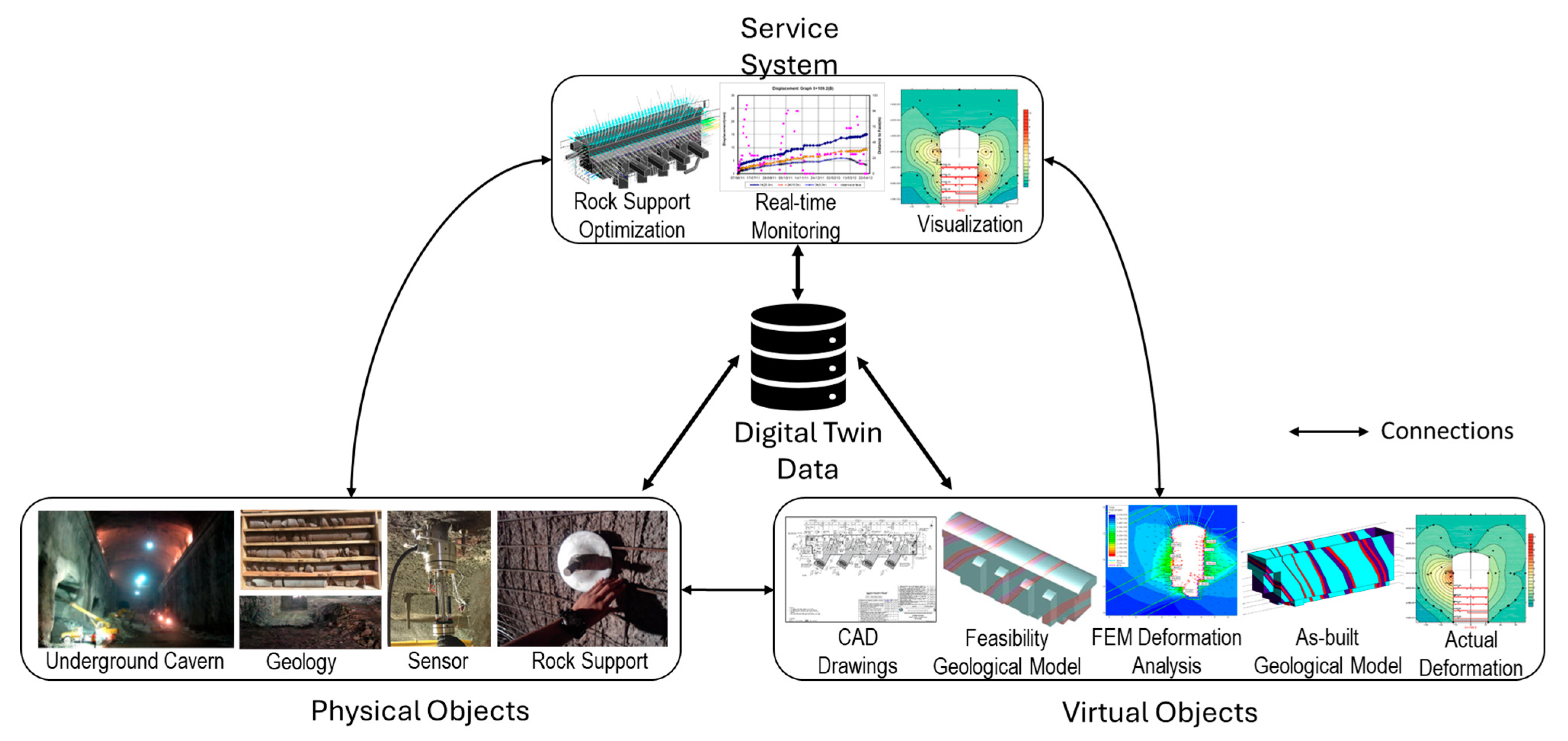
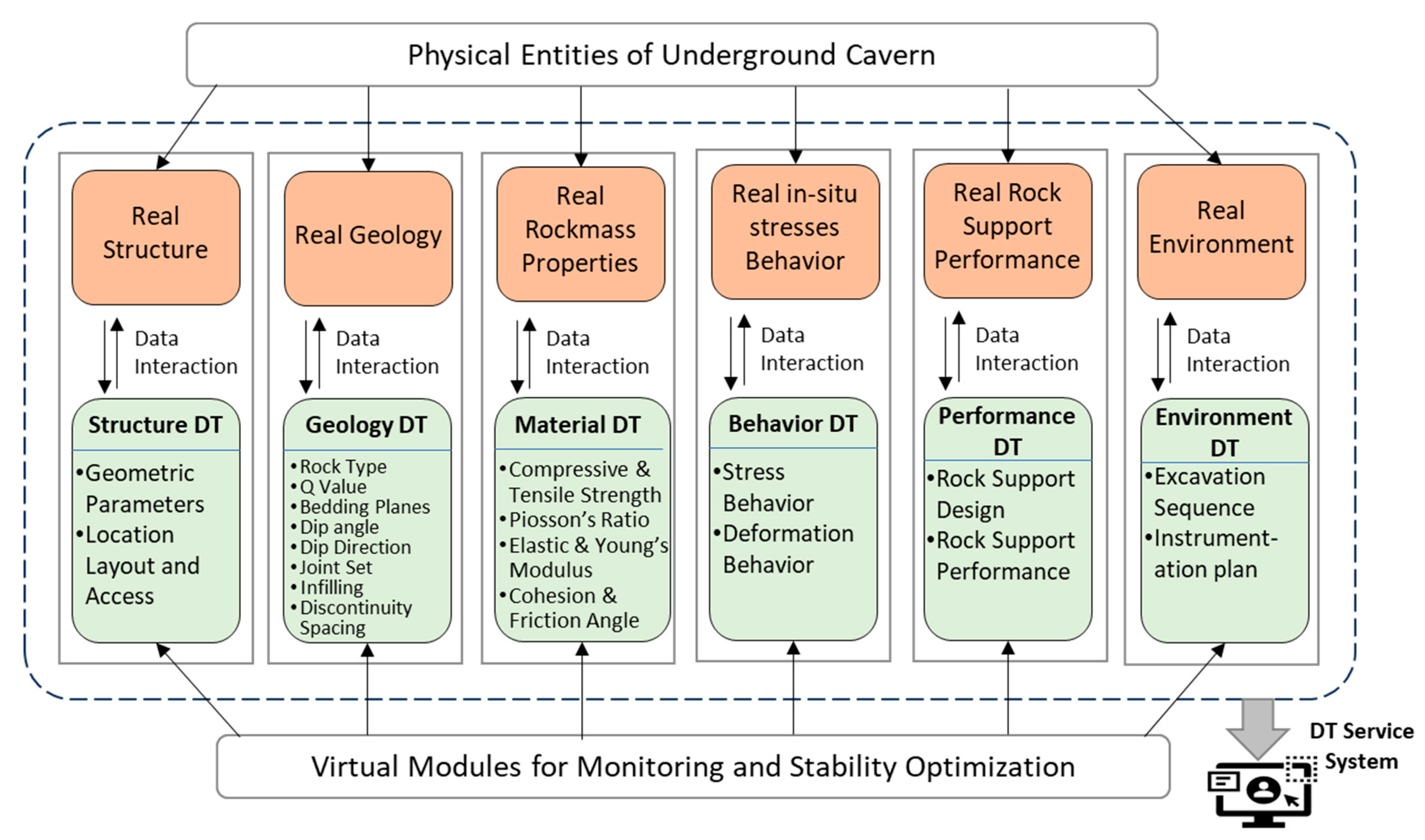
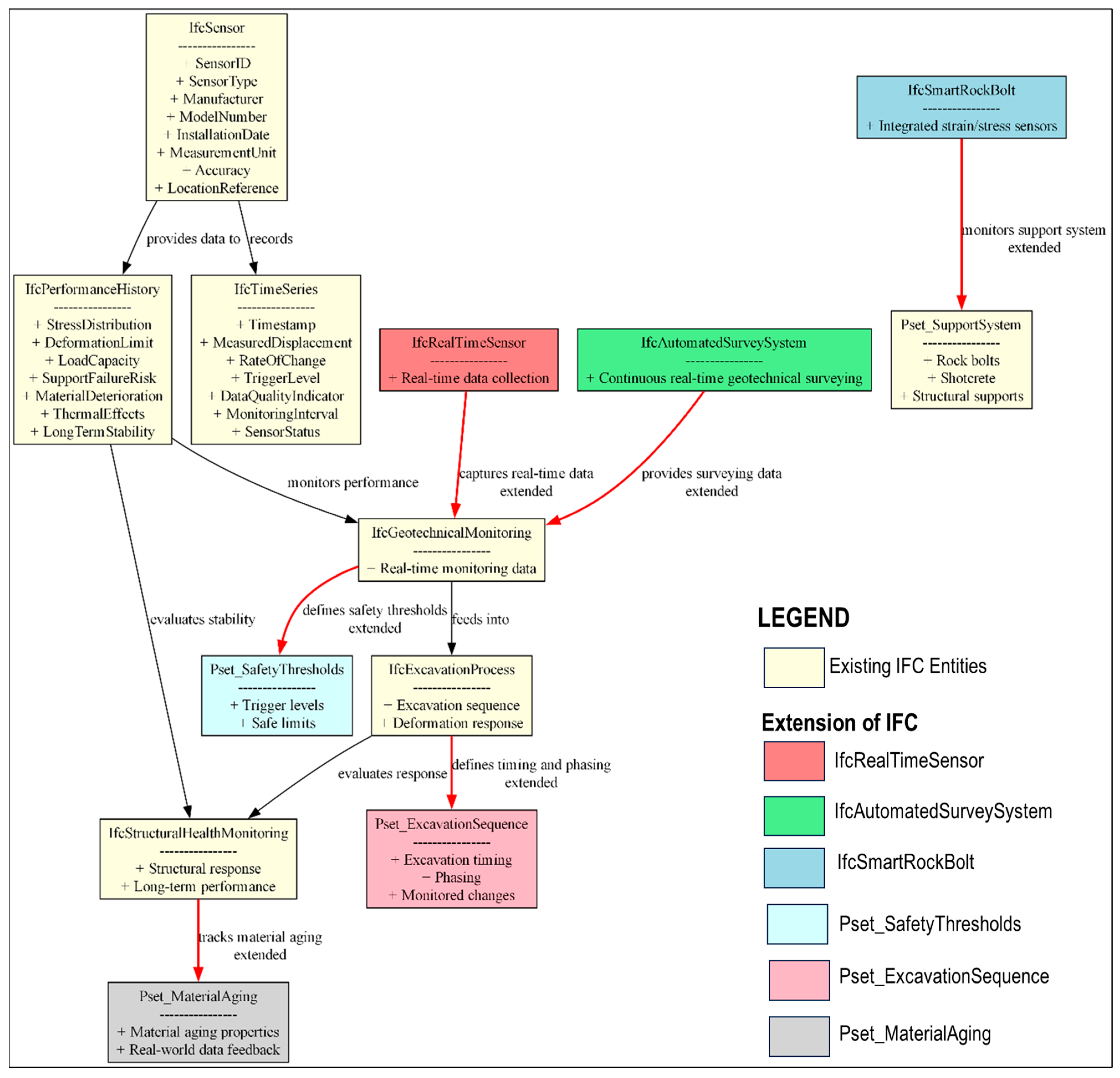

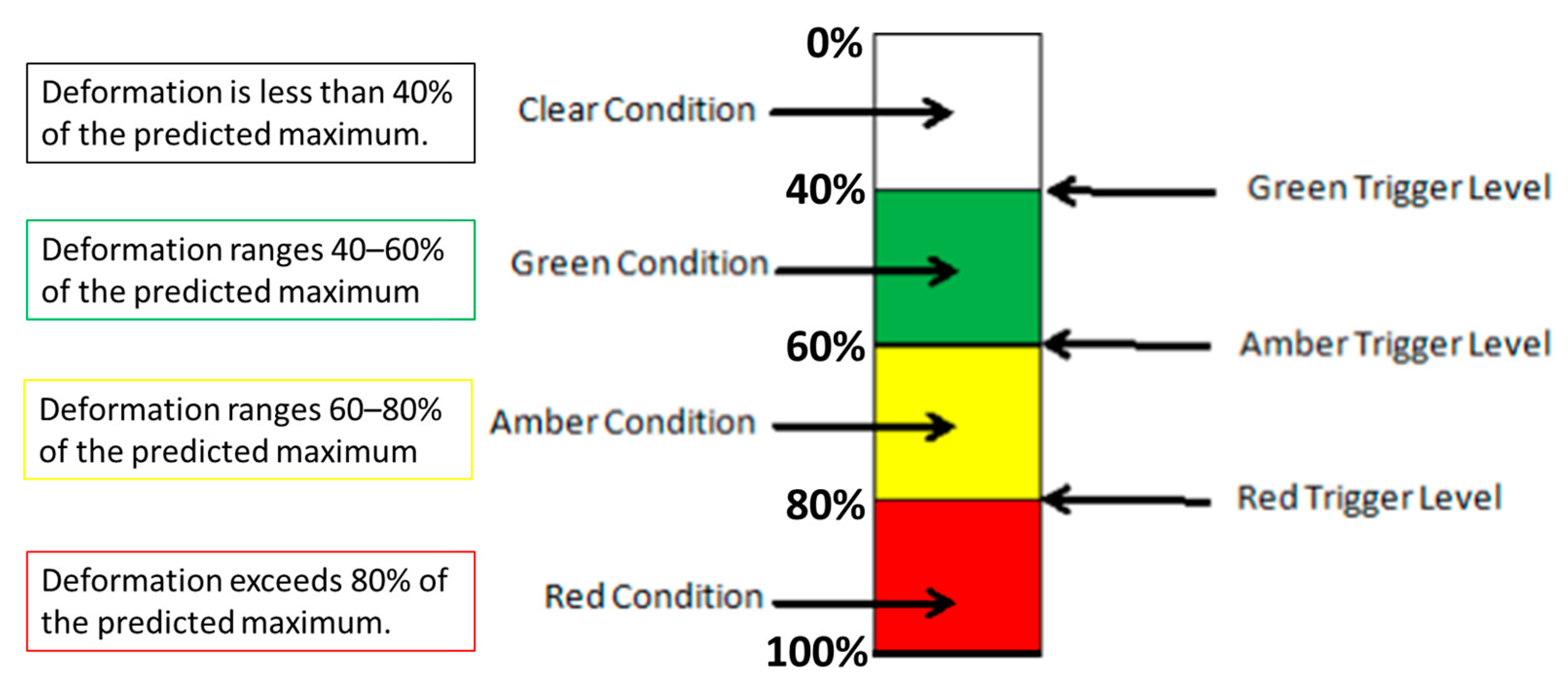


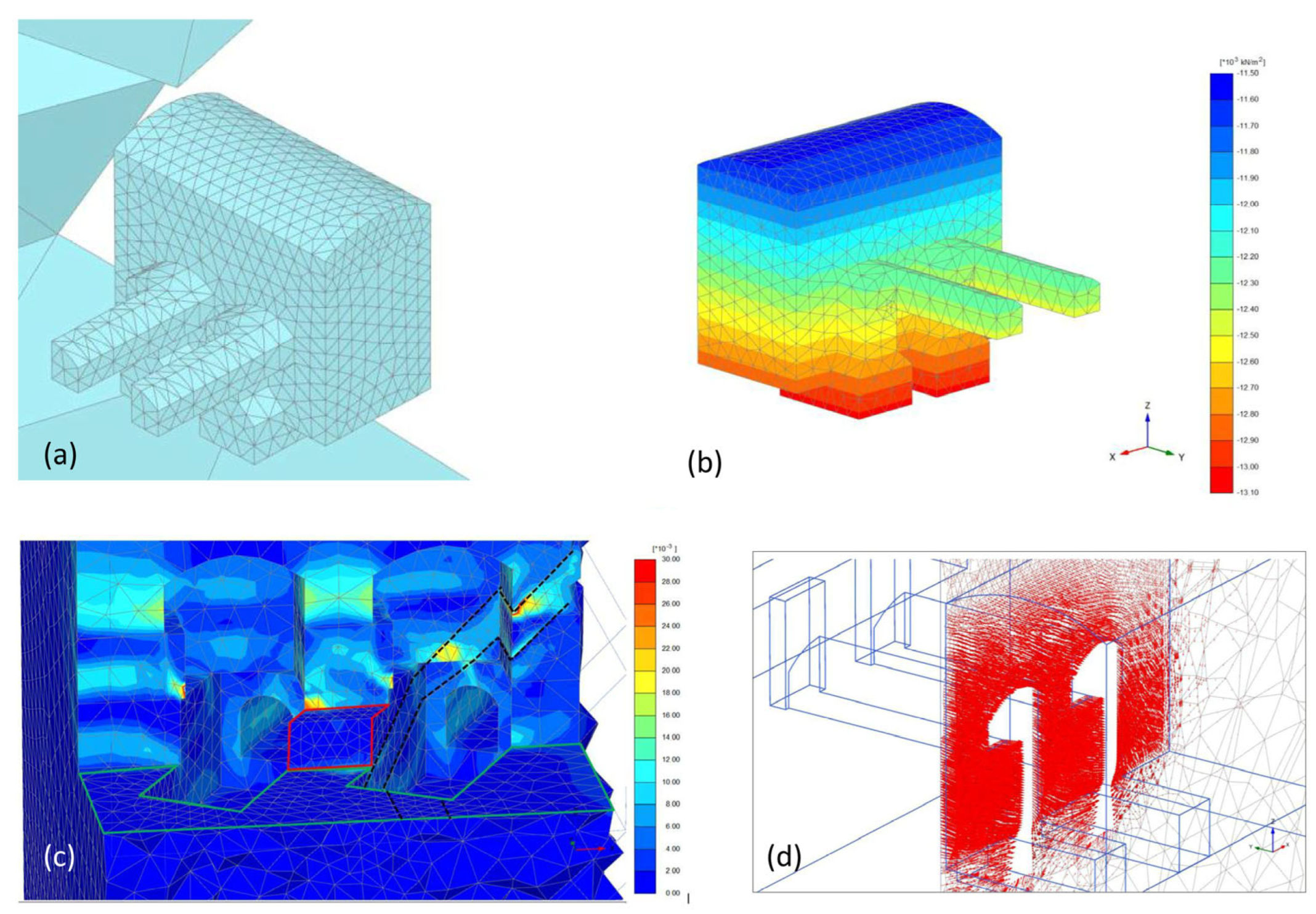
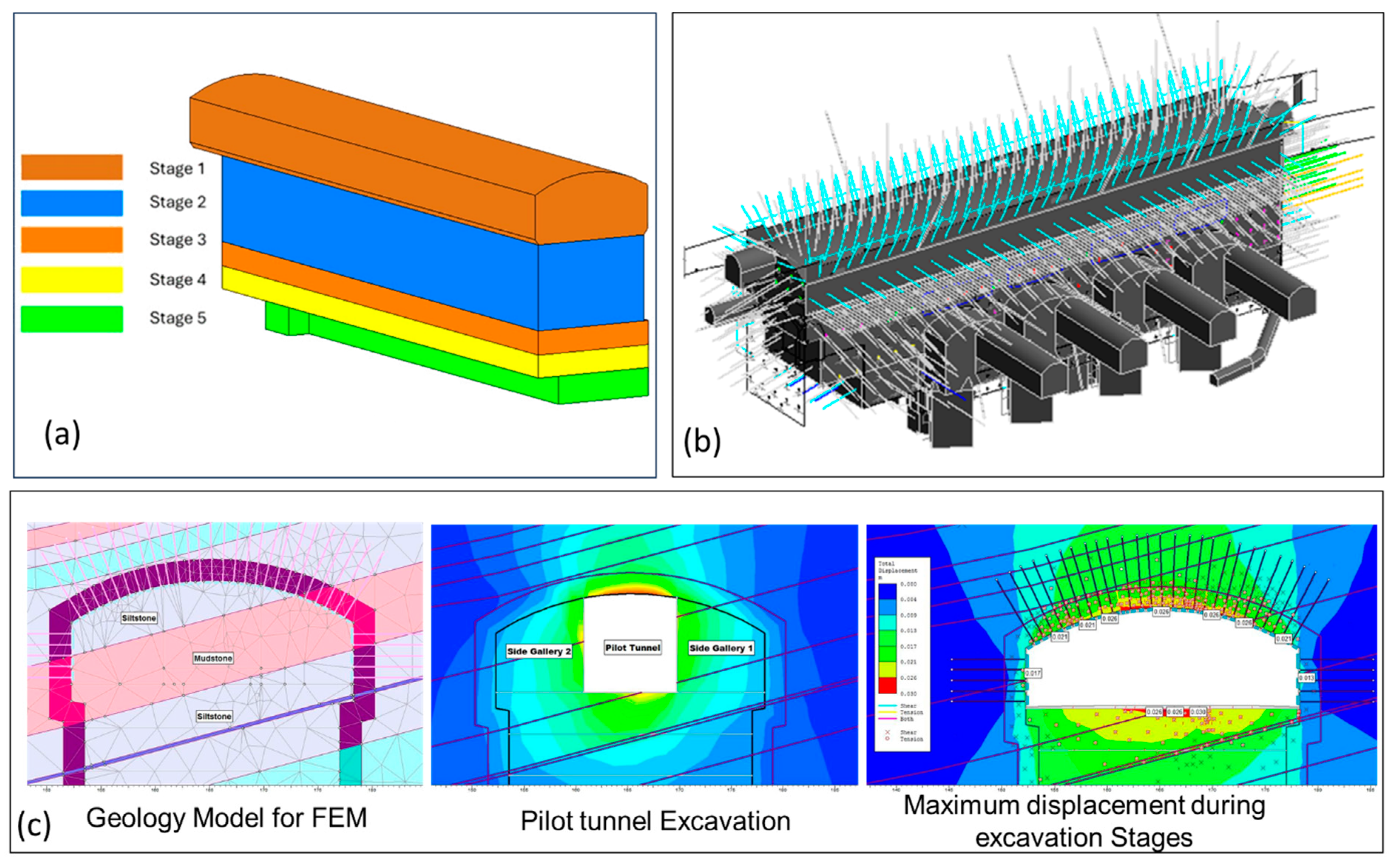
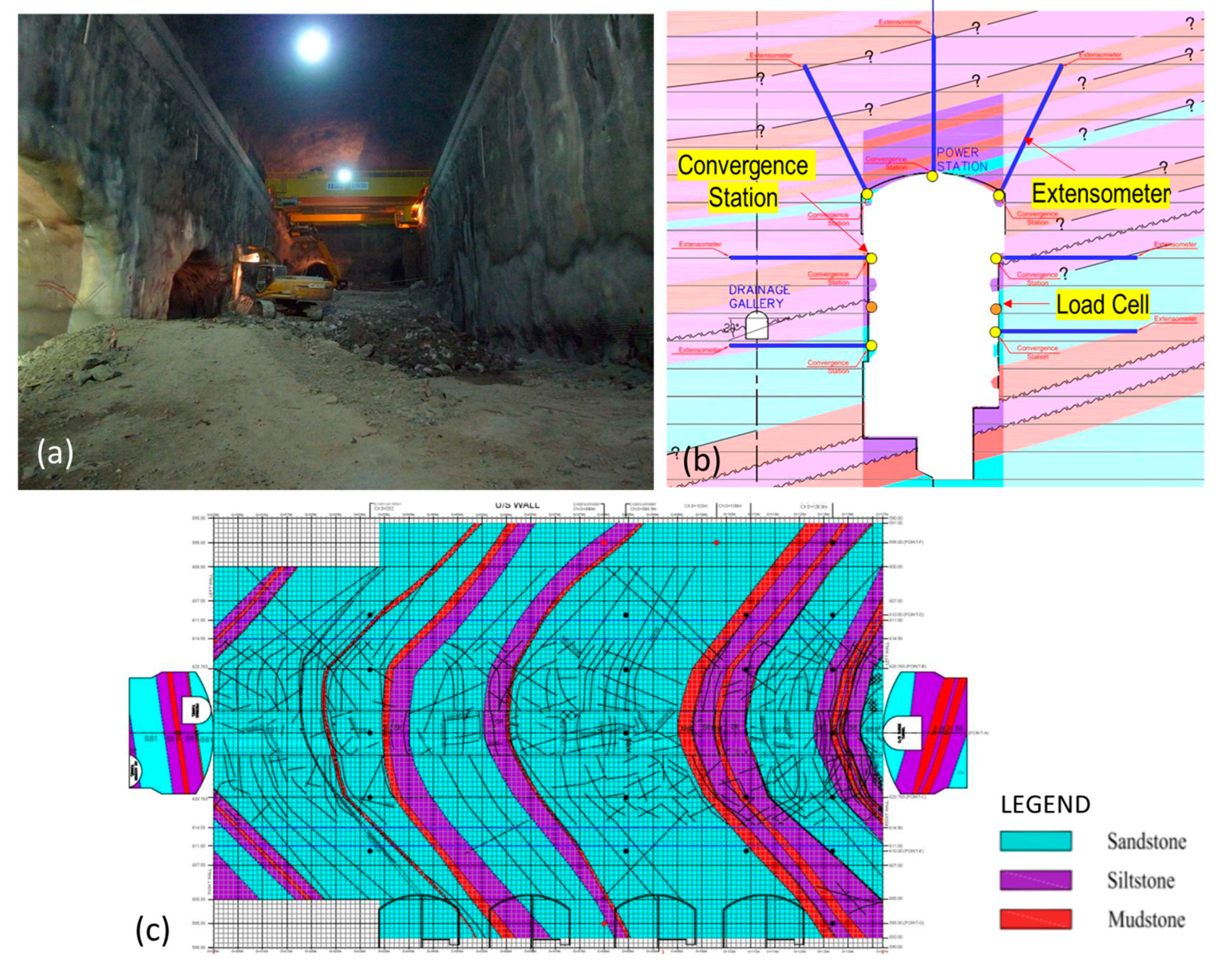
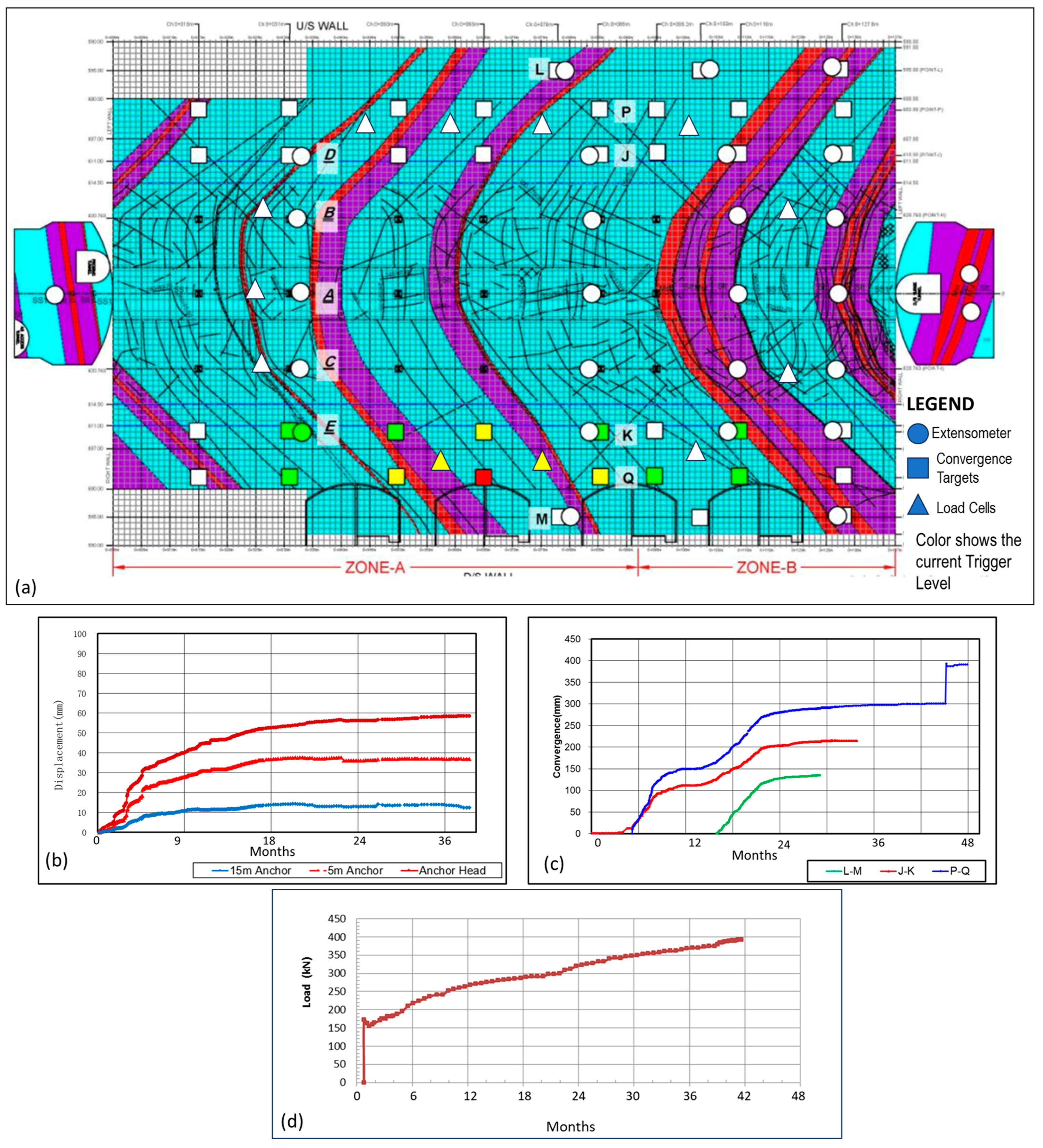
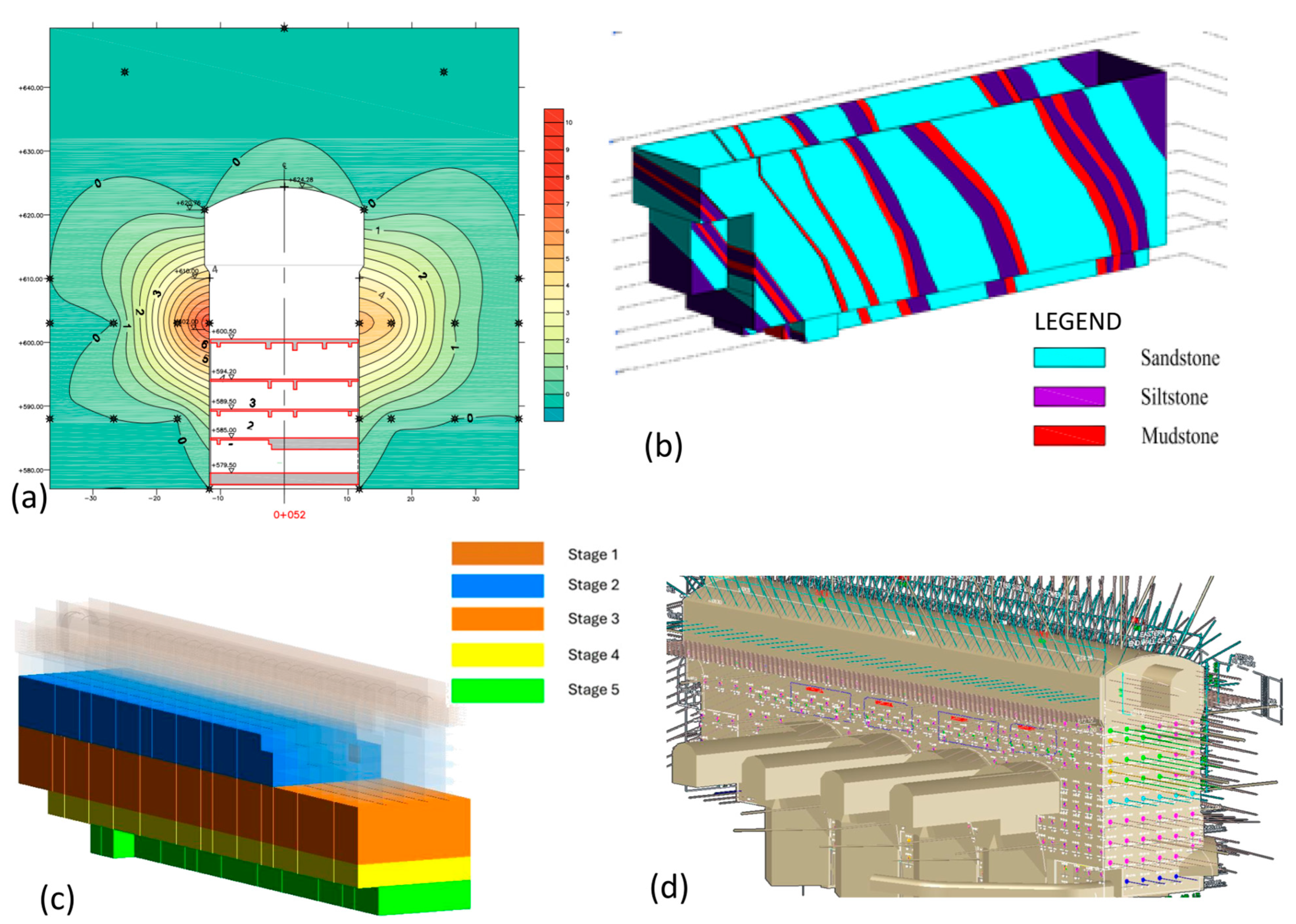
| Property Set | Attribute Name | Data Type | Description | Status |
|---|---|---|---|---|
| Pset_SensorCommonFeature | SensorID | String | Unique identifier for sensor. | Existing |
| SensorType | Enum | Type of sensor (e.g., extensometer or load cell). | Existing | |
| Manufacturer | String | Manufacturer of sensor device. | Existing | |
| ModelNumber | String | Model number of sensor. | Existing | |
| InstallationDate | Date | Date when sensor was installed. | Existing | |
| MeasurementUnit | String | Unit of measurement (e.g., mm or kN). | Existing | |
| Accuracy | Double | Accuracy of sensor readings. | Existing | |
| LocationReference | String | Position of sensor in BIM model. | Existing | |
| OperatingRange | Double | Range of values that sensor can measure. | Extended | |
| PowerSupply | String | Type of power supply (e.g., battery or wired). | Extended | |
| CommunicationProtocol | String | Type of communication protocol (e.g., LoRa or Zigbee). | Extended | |
| Pset_SensorMonitoringData | Timestamp | DateTime | Time when measurement was taken. | Existing |
| MeasuredDisplacement | Double | Recorded displacement value (in mm). | Existing | |
| RateOfChange | Double | Rate of displacement change over time. | Existing | |
| TriggerLevel | Enum | Alert level (Green, Amber, or Red). | Existing | |
| DataQualityIndicator | Enum | Status of data validity (Valid, Warning, or Error). | Existing | |
| MonitoringInterval | String | Frequency of data collection (e.g., hourly or daily). | Existing | |
| SensorStatus | Enum | Operational status of sensor (Active or Faulty). | Existing | |
| EnvironmentalFactors | String | External influences on sensor readings. | Extended | |
| CalibrationStatus | Enum | Indicates if sensor has been calibrated. | Extended | |
| Pset_PerformanceData | StressDistribution | Double | Numeric value for stress analysis results. | Existing |
| DeformationLimit | Double | Threshold for safe deformation. | Existing | |
| LoadCapacity | Double | Structural load-bearing capacity of supports. | Existing | |
| SupportFailureRisk | Double | Calculated risk factor for support failure. | Extended | |
| MaterialDeterioration | Double | Rate of material degradation over time. | Extended | |
| ThermalEffects | Double | Impact of temperature variations on performance. | Extended | |
| LongTermStability | Enum | Stability classification based on historical data. | Extended | |
| CorrosionResistance | Enum | Corrosion resistance level of support materials. | Extended | |
| FatigueAnalysis | Boolean | Indicates if fatigue analysis has been conducted. | Extended | |
| StructuralHealthScore | Double | Computed score reflecting overall structural health. | Extended |
| Category | Name | Description |
|---|---|---|
| New IFC Entities | IfcGeotechnicalMonitoring | Represents real-time geotechnical monitoring data. |
| IfcExcavationProcess | Tracks excavation sequence and deformation response. | |
| IfcStructuralHealthMonitoring | Records structural response and long-term performance of infrastructure. | |
| New Property Sets | Pset_ExcavationSequence | Stores excavation timing, phasing, and monitored changes. |
| Pset_MaterialAging | Defines material aging properties based on real-world data feedback. | |
| Pset_SupportSystem | Captures data about rock bolts, shotcrete, and other structural supports. | |
| Pset_SafetyThresholds | Defines trigger levels for deformation and stress beyond safe limits. | |
| Extended Types | IfcRealTimeSensor | A specialized sensor type for capturing real-time deformation and stress. |
| IfcSmartRockBolt | A rock bolt equipped with integrated strain and stress sensors. | |
| IfcAutomatedSurveySystem | A system capable of continuous real-time geotechnical surveying. |
| Rock Type | Properties of Intact Rock | Rock Mass Parameters for Powerhouse (Avg. Rock Cover = 430 m) | |||||
|---|---|---|---|---|---|---|---|
| UCS (MPa) | GSI | Elastic Modulus (Ei) (GPa) | Material Constant (mi) | Cohesion (c) (MPa) | Friction Angle (°) | Young’s Modulus (Emr) (MPa) | |
| Sandstone (SS-1) | 80–92 | 60–68 | 30–34 | 16–18 | 2.5–3.1 | 49–52 | 19,500–21,000 |
| Sandstone (SS-2) | 43–50 | 48–52 | 17–20 | 16–18 | 1.4–1.8 | 40–43 | 6800–7500 |
| Siltstone | 62–70 | 48–52 | 21–25 | 6–8 | 1.3–1.7 | 35–38 | 6800–7400 |
| Mudstone | 38–46 | 48–52 | 11–14 | 8–10 | 1.1–1.5 | 34–37 | 3500–4200 |
| Evaluation Metric | Digital Twin-Driven Framework | Traditional Method | |
|---|---|---|---|
| 1. Deformation monitoring | Maximum Convergence (mm) | ±10–20% deviation from predicted values due to real-time updates | ±30–50% deviation due to limited periodic monitoring |
| Rate of Deformation (mm/day or mm/month) | Continuous monitoring for early detection | Manual readings at fixed intervals; higher risk of late detection | |
| Deformation Reduction (%) (before vs. after support installation) | 30–50% reduction with optimized rock support | 10–20% reduction due to static design assumptions | |
| 2. Rock support optimization | Rock Support Effectiveness (% reduction in critical failure zones) | 40–60% due to predictive modeling and feedback loops | 15–30% due to predefined static designs |
| Support utilization efficiency (kN/m2) | Optimized based on real-time stress analysis | Over-designed due to lack of real-time stress feedback | |
| 3. Real-time monitoring accuracy | Sensor accuracy (% deviation from predicted values) | ±5–10% (validated against simulation models) | ±25–40% (manual measurements introduce errors) |
| Data latency | Real-time data integration | Delayed by hours/days due to manual processing | |
| 4. Stress and stability analysis | Factor of Safety (FoS) | Maintained dynamically (>1.2) with real-time updates | Calculated in design phase, may not reflect actual conditions |
| Stress Redistribution Efficiency (% change in stress post-excavation) | 30–50% improvement due to adaptive modifications | 10–20% improvement with static support design | |
| Shear strain concentration (%) | Identified dynamically to prevent failure | Identified post-failure in most cases | |
| 5. BIM-based construction efficiency | Deviation from Planned Excavation Sequence (%) | <10% due to continuous design refinements | >25% due to unforeseen site conditions |
| Design Modifications (% changes in geometry or structural design) | Adjusted dynamically with real-time feedback | Requires significant redesign and delays | |
| Real-time Model Update Frequency (updates per day/week) | Continuous updates (daily/hourly) | Updated manually (weekly or monthly) | |
| Decision Response Time (hours or days) | Immediate corrective actions | Delayed response due to manual assessments | |
Disclaimer/Publisher’s Note: The statements, opinions and data contained in all publications are solely those of the individual author(s) and contributor(s) and not of MDPI and/or the editor(s). MDPI and/or the editor(s) disclaim responsibility for any injury to people or property resulting from any ideas, methods, instructions or products referred to in the content. |
© 2025 by the authors. Licensee MDPI, Basel, Switzerland. This article is an open access article distributed under the terms and conditions of the Creative Commons Attribution (CC BY) license (https://creativecommons.org/licenses/by/4.0/).
Share and Cite
Sharafat, A.; Tanoli, W.A.; Zubair, M.U.; Mazher, K.M. Digital Twin-Driven Stability Optimization Framework for Large Underground Caverns. Appl. Sci. 2025, 15, 4481. https://doi.org/10.3390/app15084481
Sharafat A, Tanoli WA, Zubair MU, Mazher KM. Digital Twin-Driven Stability Optimization Framework for Large Underground Caverns. Applied Sciences. 2025; 15(8):4481. https://doi.org/10.3390/app15084481
Chicago/Turabian StyleSharafat, Abubakar, Waqas Arshad Tanoli, Muhammad Umer Zubair, and Khwaja Mateen Mazher. 2025. "Digital Twin-Driven Stability Optimization Framework for Large Underground Caverns" Applied Sciences 15, no. 8: 4481. https://doi.org/10.3390/app15084481
APA StyleSharafat, A., Tanoli, W. A., Zubair, M. U., & Mazher, K. M. (2025). Digital Twin-Driven Stability Optimization Framework for Large Underground Caverns. Applied Sciences, 15(8), 4481. https://doi.org/10.3390/app15084481





